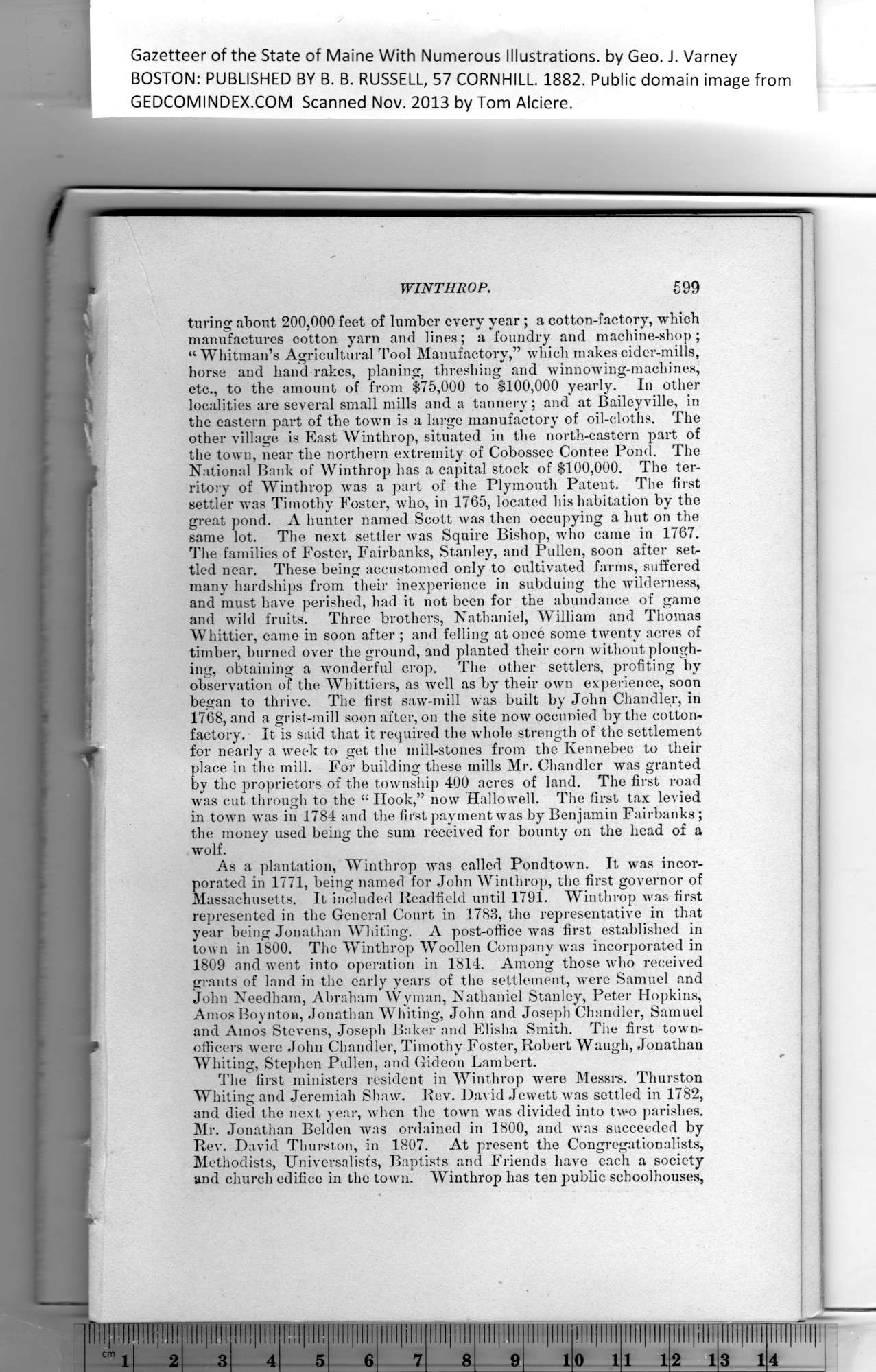|
Gazetteer of the State of Maine With Numerous Illustrations, by Geo. J. Varney
BOSTON: PUBLISHED BY B. B. RUSSELL, 57 CORNHILL. 1882. Public domain image from
• WINTHROP. 599
turing about 200,000 feet of lumber every year; a cotton-factory, which
manufactures cotton yarn and lines; a foundry and machine-shop ;
I “ Whitman’s Agricultural Tool Manufactory,” wliicli makes cider-mills,
horse and hand rakes, planing, threshing and winnowing-machines,
etc., to the amount of from $75,000 to $100,000 yearly. In other
localities are several small mills and a tannery; and at Baileyville, in
the eastern part of the town is a large manufactory of oil-cloths. The
other village is East Winthrop, situated in the north-eastern part of
the town, near tbe northern extremity of Cobossee Contee Pond. The
National Bank of Winthrop lias a capital stock of $100,000. The ter-
f ritory of Winthrop was a part of the Plymouth Patent. The first
settler was Timothy Foster, who, in 1765, located his habitation by the
great pond. A hunter named Scott was then occupying a hut on the
game lot. The next settler was Squire Bishop, who came in 1767.
The families of Foster, Fairbanks, Stanley, and Pullen, soon after set-
tled near. These being accustomed only to cultivated farms, suffered
many hardships from their inexperience in subduing the wilderness,
and must have perished, had it not been for the abundance of game
and wild fruits. Three brothers, Nathaniel, William and Thomas
Whittier, came in soon after ; and felling at once some twenty acres of
timber, burned over the ground, and planted their corn without plough-
ing, obtaining a wonderful crop. The other settlers, profiting by
observation of the Wbittiers, as well as by their own experience, soon
began to thrive. The first saw-mill was built by John Chandler, in
1768, and a grist-mill soon after, on tbe site now occnnied by the cotton-
factory. It is said that it required the whole strength of the settlement
for nearly a week to get the mill-stones from the Kennebec to their
place in the mill. For building these mills Mr. Chandler was granted
by the proprietors of the township 400 acres of land. The first road
was cut through to the “ Hook,” now Hallowell. The first tax levied
in town was in 1784 and the first payment was by Benjamin Fairbanks ;
the money used being the sum received for bounty on the head of a
wolf.
As a plantation, Winthrop was called Pondtown. It was incor-
porated in 1771, being named for John Winthrop, the first governor of
Massachusetts. It included Readfield until 1791. Winthrop was first
represented in the General Court in 1783, the representative in that
year being Jonathan Whiting. A post-office wras first established in
town in 1800. The Winthrop Woollen Company was incorporated in
1809 and went into operation in 1814. Among those who received
grants of land in the early years of the settlement, were Samuel and
John Needham, Abraham Wyman, Nathaniel Stanley, Peter Hopkins,
Amos Boynton, Jonathan Whiting, John and Joseph Chandler, Samuel
and Amos Stevens, Joseph Baker and Elisha Smith. The first town-
t officers were John Chandler, Timothy Foster, Robert Waugh, Jonathan
Whiting, Stephen Pullen, and Gideon Lambert.
The first ministers resident in Winthrop were Messrs. Thurston
Whiting and Jeremiah Shaiv. Rev. David Jewett was settled in 1782,
and died the next year, when the town was divided into two parishes.
Mr. Jonathan Belden was ordained in 1800, and was succeeded by
Rev. David Thurston, in 1807. At present the Congregationalists,
Methodists, Universalists, Baptists and Friends have each a society
and church edifice in the town. Winthrop has ten public schoolhouses,
PREVIOUS PAGE ... NEXT PAGE
This page was written in HTML using a program written in Python 3.2
|
